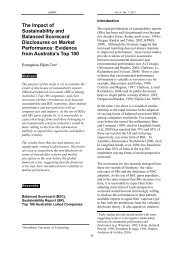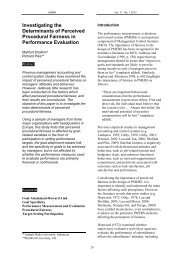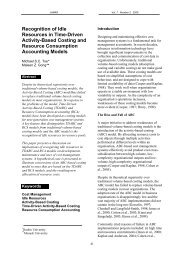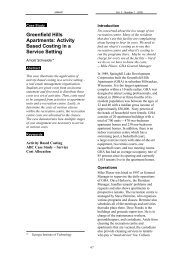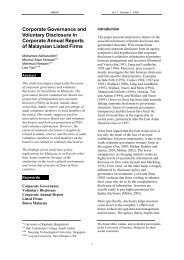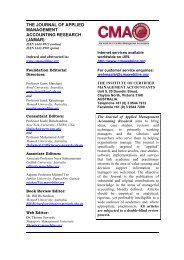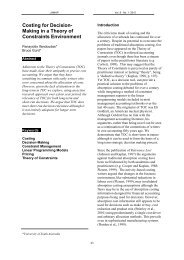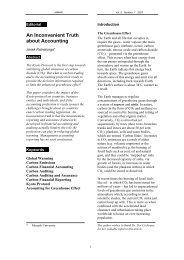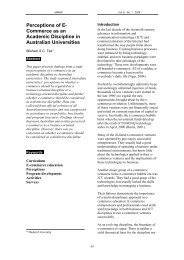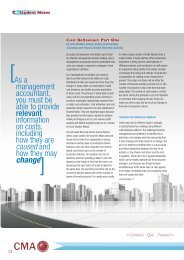Balanced Scorecard Design and Performance Impacts: Some ...
Balanced Scorecard Design and Performance Impacts: Some ...
Balanced Scorecard Design and Performance Impacts: Some ...
Create successful ePaper yourself
Turn your PDF publications into a flip-book with our unique Google optimized e-Paper software.
JAMAR Vol. 6 · Number 2 · 2008The averages reported in Table 6 for theorganisations that have implemented at theteam <strong>and</strong> individual levels are higher for allbut one outcome <strong>and</strong> one benefit measurehowever there are no statistically significantdifferences. A number of other bases werealso used for categorising firms as high <strong>and</strong>low implementers, but these had no notableimpact on results. While no support isprovided for the third proposition as themajority of firms have implemented theBSC to lower levels of the organisation it islikely that there is some benefit to doing so,although it has not been captured in thisstudy.Additional Test on Cause <strong>and</strong> Effect <strong>and</strong>CompensationWith strong support for proposition one <strong>and</strong>some support for proposition two,additional tests were run. These additionaltests considers whether compensation <strong>and</strong>cause <strong>and</strong> effect characteristics contributedto BSC effects independently, or if therewas some form of interaction effectbetween the two. Firms were partitionedinto four groups based on the existence orabsence of cause <strong>and</strong> effect <strong>and</strong> link fromnon-financial measures to compensation.The results of Mann-Whitney U-testsbetween groups are shown in Table 7.The tests demonstrate that thecompensation characteristic has littleindependent effect on BSC benefits <strong>and</strong>outcomes (group one v three). When cause<strong>and</strong> effect is not part of the BSC design, theinclusion of compensation provides nosignificant difference in benefits. Theresults do provide evidence that the use ofcause <strong>and</strong> effect logic has an independenteffect on BSC benefits, although it appearsto be more important when compensation isalso included.All of the outcome measures <strong>and</strong> nine of the11 benefits were significantly higher whencause <strong>and</strong> effect logic was used with a BSCtied to compensation (group three v four).When the compensation link was absent,four of the benefit measures weresignificantly higher with the use of cause<strong>and</strong> effect, although all of the reportedaverages for benefits <strong>and</strong> two of theoutcome measures were higher (group onev two). In comparing a BSC design withboth compensation <strong>and</strong> cause <strong>and</strong> effect toone that only includes the latter (group twov four), only one benefit is significantlyhigher, although the outcome of ‘overallsuccess’ is moderately significant.The additional tests, in conjunction with theinitial proposition tests, suggest that linkingnon-financial BSC measures tocompensation may not be a requisite forsuccessful use of the BSC, <strong>and</strong> that cause<strong>and</strong> effect is the dominant characteristicconsidered in this study of BSC design.However, if compensation is included aspart of BSC design, there appears to be aninteraction effect with cause <strong>and</strong> effect.Whether the compensation characteristic isincluded or not may relate to the role thatthe BSC plays in the control package mix,or upon other contingent circumstances.Discussion <strong>and</strong> ConclusionThis study was designed to find out how<strong>Balanced</strong> <strong>Scorecard</strong>s have been applied inpractice <strong>and</strong> whether different BSC designsresult in varying benefits <strong>and</strong> performanceoutcomes. A number of interesting findingsemerged. First, deriving measures usingcause <strong>and</strong> effect logic seem to enhanceperceived benefits <strong>and</strong> performanceoutcomes from the BSC. Given the widerange of benefits received, it is difficult topoint out any single underlying factordriving these results. However, as cause <strong>and</strong>effect logic seemed to bring more benefitsfor firms that linked compensation to nonfinancials,benefits could partly be due tothis type of BSC making management byobjectives based control system reflect whatis truly believed to be of strategicimportance in the organisation.The reliance on cause <strong>and</strong> effect may helpto reduce <strong>and</strong> prioritise objectives,providing more focused target setting <strong>and</strong>accountabilities, compared to a BSC whereobjectives are grouped into perspectives butno clear underst<strong>and</strong>ing exists on theirinterdependencies. Balancing variousoutcome measures with drivers of thosemeasures in management by objectivessystems may bring many of these benefits.30



